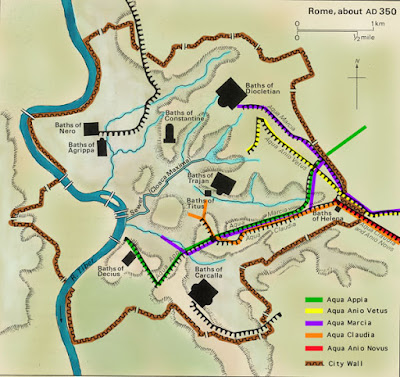Just as
is today, in Antiquity the larger the city the more vast their support systems
were required to be. Rome, being the largest city in the world during its
Empirical peak, obviously needed a system large enough to supply its civilians
with water. Though many towns in the Roman Empire were lucky to even have an
aqueduct feeding it, Rome with its million plus inhabitants required eleven to operate,
in addition to private wells. Frontinus, the curator aquarum (water commissioner and caretaker of the aqueducts) of Rome under the reign of Nerva, gives
us a completely unique text in his De
Aquaeductu Urbis Romae by providing us with statistics and information
about the first nine of Rome’s water channels that are found nowhere else. This
post will be exploring the first four of Rome’s aqueducts, aka those which were
built in the Republic, via Frontinus’s information.
1.
Aqua Appia
Built in 312
BCE by Appius Claudius Caecus, the Appia was a primarily underground aqueduct
running for 16⅙ km from its underground springs east of the city. It served
mainly the commercial district of the Forum Boarium and Porta Trigemina,
travelling under both the Caelian and Aventine hill to reach its termination
point near the Tiber River. As the first aqueduct of Rome it was a stunning
architectural innovation and achievement.
2.
Aqua Anio Vetus
Coming from
the Appian Valley north of the city, the Aqua Anio Vetus was constructed around
272 BCE and travelled a much longer distance (81 km) than the Appia to its
terminal in Rome, the Porta Esquiline. It’s source was the surface level Anio River, and thus had lower
quality waters than the Appia due to silt accumulation, but produced more water
and had a wider reach within the city, especially eastwards – indicating growth
in that direction of Rome.
3.
Aqua Marcia
Rome’s third
aqueduct is not built for another 130 years after the Anio Vetus in 144 BCE
because of massive strains on water resources, especially after the Second
Punic War. The Aqua Marcia was therefore constructed to have an even larger extent
and output than the Anio Vetus. Coming from an underground spring even further
up the Anio Vally, it travelled over 91 km before supplying the Capitoline,
Palatine, Caelian, and Aventine hills from its various terminals. The Marcia
was well renowned for its cold, clean water and was often the preferred aqueduct
of the city, until the imperial period.
4.
Aqua Tepula
There is
little to say about the Aqua Tepula as it was primarily a line built to supplement
the Aqua Marcia only 19 years later. Unfortunately, Frontinus is not very interested
in the Tepula and so there is very little literary evidence for it. Combined
with the utter lack of archaeological sources, the length is unknown. We do
know that it delivered to the same regions as the Marcia, and considering the
lack of distance between the building times and distribution area’s it can be
inferred that Rome was having massive population spikes at this point in time.
The majority of aqueducts were built during the Imperial
Period. The remaining seven of these will be explored in a subsequent post.
Bibliography
 |
| A Map of Rome's Aqueducts. The Green, Yellow, and Purple are the Republican Channels (http://aquaduct.hobbysite.info/romead350.html) |
Bibliography
Evans, Harry
B. Water Distribution in Ancient Rome: The Evidence of Frontinus. Ann
Arbor:
University of Michigan Press, 1994.
Frontinus. Stratagems. Aqueducts of Rome. Translated
by C. E. Bennett, Mary B.
McElwain. Loeb
Classical Library 174. Cambridge, MA: Harvard University Press, 1925.

No comments:
Post a Comment